Appliances
Why Is My Ceiling Fan Squeaking
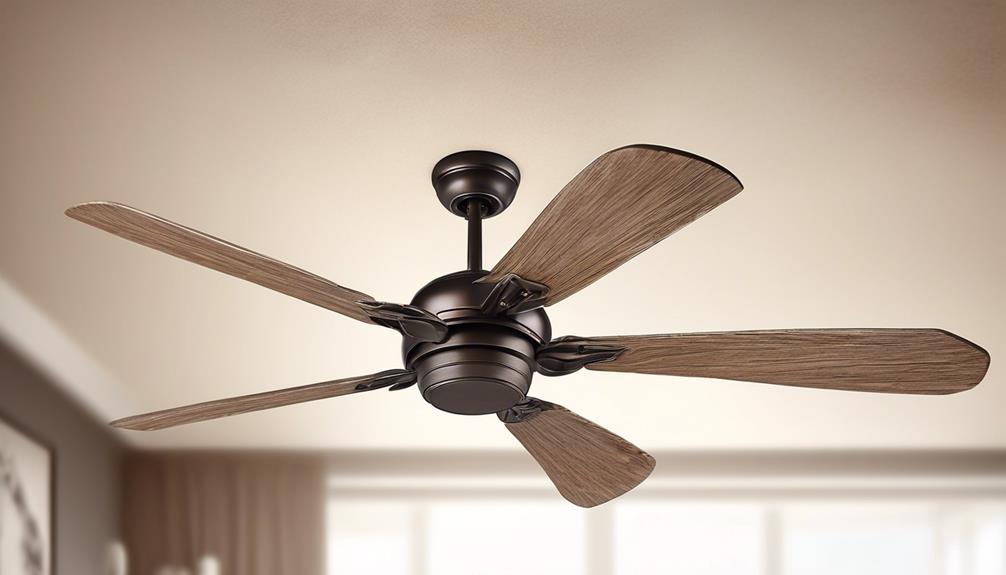
While we’re nestled in our homes, searching for relief from the blazing sun, our trusted ceiling fans tirelessly rotate overhead, offering a delicate wind amidst the oppressive heat. Yet unexpectedly, in the midst of the comforting hum of the blades, an intrusive noise appears – a constant squeak that shatters our tranquility.
We find ourselves wondering, 'Why is our ceiling fan squeaking?' Fear not, for we are here to shed light on this vexing issue. In this brief guide, we will explore the various reasons behind this unpleasant noise, ranging from loose screws and bolts to imbalanced fan blades and worn-out bearings.
By understanding the causes, we can take the necessary steps to restore tranquility to our homes and reclaim the soothing ambiance of our ceiling fans.
Key Takeaways
- Loose screws and bolts throughout the fan can contribute to squeaking
- Imbalanced fan blades can cause the fan to squeak
- Worn-out bearings can lead to squeaking and should be replaced
- Dust and dirt buildup on the fan blades and moving parts can cause squeaking
Loose Screws and Bolts
First, we need to inspect the ceiling fan for any loose screws and bolts that may be causing the squeaking noise. When it comes to ceiling fans, even the smallest loose screw or bolt can lead to annoying noises and vibrations. To address this issue, we must tighten all the bolts and screws throughout the fan.
To begin, turn off the fan and locate the screws and bolts holding the fan blades to the motor housing. Using a screwdriver or a wrench, carefully tighten each one, making sure not to overtighten. It's important to check all the screws and bolts, including those securing the motor housing and the downrod.
If the squeaking noise persists, it's possible that some screws or bolts have become stripped or worn out. In this case, it may be necessary to replace them with new ones. Ensure that the replacements are the appropriate size and fit securely.
Imbalanced Fan Blades
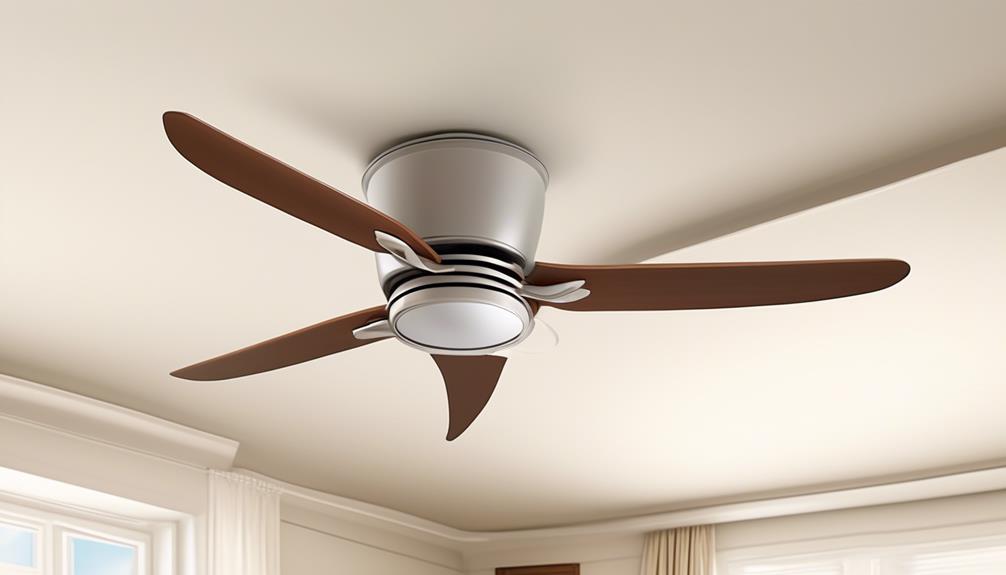
To address the issue of imbalanced fan blades, it's important to ensure that each blade is properly aligned and weighted for optimal performance. Imbalanced fan blades can cause excessive vibrations, leading to annoying squeaking noises.
Here are four steps to maintain and troubleshoot imbalanced fan blades:
- Check for loose or damaged blades: Inspect each blade for any signs of damage, such as cracks or chips. Tighten any loose screws or bolts that connect the blades to the fan motor.
- Balance the blades: Use a blade-balancing kit or a bubble level to determine which blade is causing the imbalance. Attach a balancing clip to the lighter side of the blade, gradually moving it towards the tip until the fan operates smoothly.
- Clean the blades: Dust and debris can accumulate on the blades, affecting their balance. Regularly clean the blades using a soft cloth or a vacuum cleaner attachment to maintain optimal performance.
- Replace worn-out blades: If the fan blades are severely damaged or worn-out, it may be necessary to replace them entirely. Ensure that the replacement blades are compatible with your fan model.
Worn-Out Bearings
One common cause of ceiling fan squeaking is worn-out bearings. These bearings can become worn down over time due to regular use and lack of proper maintenance. Bearings are small metal balls or rollers that allow the fan blades to rotate smoothly. When these bearings become worn, they lose their ability to move freely, resulting in a squeaking noise.
To troubleshoot a squeaking noise caused by worn-out bearings, there are a few steps you can take. First, turn off the fan and let it come to a complete stop. Then, locate the fan's motor housing and remove it to access the bearings. Inspect the bearings for any signs of wear or damage, such as rust or excessive dirt accumulation. If the bearings are worn out, they'll need to be replaced.
To replace worn-out bearings, you'll need to purchase a replacement kit that includes new bearings. Follow the manufacturer's instructions for removing the old bearings and installing the new ones. Make sure to clean any dirt or debris from the fan's motor housing before reassembling it.
Dust and Dirt Buildup
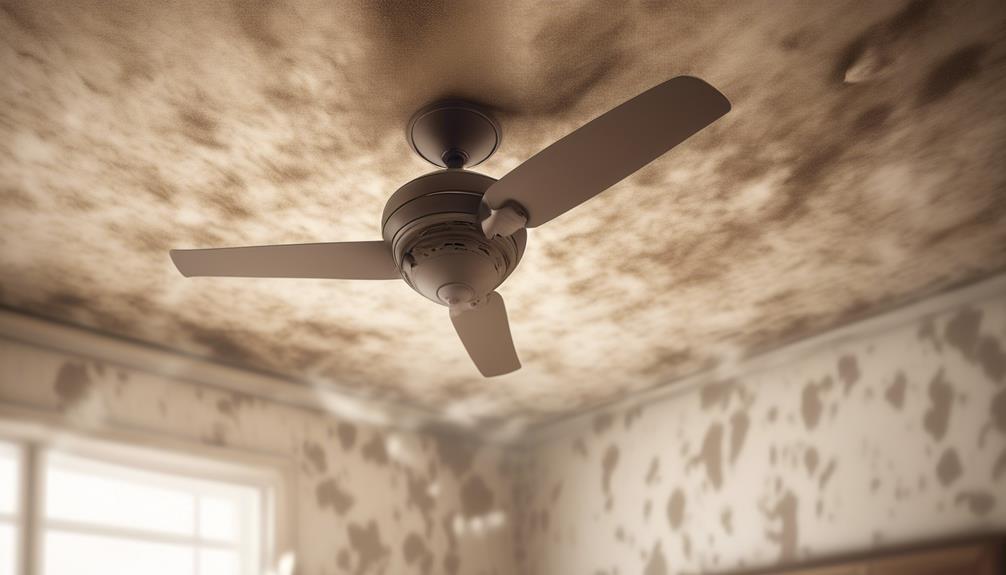
When it comes to addressing dust and dirt buildup in ceiling fans, there are a few key points to consider.
First, cleaning the fan blades regularly is crucial to prevent the accumulation of debris that can cause squeaking.
Second, lubricating the moving parts, such as the motor and bearings, helps reduce friction and noise.
Lastly, it's important to check for any loose screws or connections that could contribute to the squeaking issue.
Cleaning Fan Blades
With the accumulation of dust and dirt on the fan blades, it becomes necessary to clean them in order to maintain optimal performance and prevent any potential squeaking noises. Here are four effective cleaning techniques for fan blade maintenance:
- Start by turning off the fan and allowing the blades to come to a complete stop. This is crucial for safety and to ensure a thorough cleaning process.
- Gently wipe the blades using a soft microfiber cloth or a feather duster to remove loose dust and dirt. Avoid using abrasive materials or harsh chemicals that could damage the blades.
- For stubborn dirt or grime, dampen the cloth with a mild cleaning solution or a mixture of water and vinegar. Wipe each blade from the base to the tip, ensuring all surfaces are cleaned.
- Once the blades are clean, dry them thoroughly to prevent any moisture buildup that could lead to rust or damage.
Lubricating Moving Parts
To effectively address the issue of dust and dirt buildup on the moving parts, it's essential to properly lubricate the ceiling fan. Lubricating the moving parts not only prevents squeaking but also ensures smooth and efficient operation of the fan.
When choosing the right lubricant, it's important to consider the specific needs of your ceiling fan. Look for a lubricant that's specifically designed for use on fans, as general-purpose lubricants may not provide the necessary protection. Silicone-based lubricants are often recommended as they offer excellent lubrication and are resistant to dust and dirt buildup.
Before applying the lubricant, make sure to clean the moving parts thoroughly to remove any existing debris. Apply a small amount of lubricant to the bearings, motor, and other moving parts, following the manufacturer's instructions.
Regular lubrication will help maintain the longevity and performance of your ceiling fan.
Checking for Loose Screws
Loose screws are a common cause of squeaking in ceiling fans and can be caused by dust and dirt buildup. Checking for loose screws is a vital step in troubleshooting a squeaky ceiling fan.
Here are four important things to consider when checking for loose screws:
- Rusty screws: Inspect the screws for any signs of rust or corrosion. Rusty screws can lead to squeaking noises as they become less secure over time.
- Loose electrical connections: Ensure that all electrical connections are tight and secure. Loose connections can cause vibrations and rattling, resulting in a squeaky fan.
- Dust and dirt buildup: Clean the fan thoroughly, paying close attention to the screws. Dust and dirt can accumulate around the screws, causing them to become loose and produce squeaking sounds.
- Tightening the screws: Use a screwdriver to tighten any loose screws. Make sure to use the appropriate size and apply enough pressure to secure the screws firmly without stripping them.
Loose Motor Housing
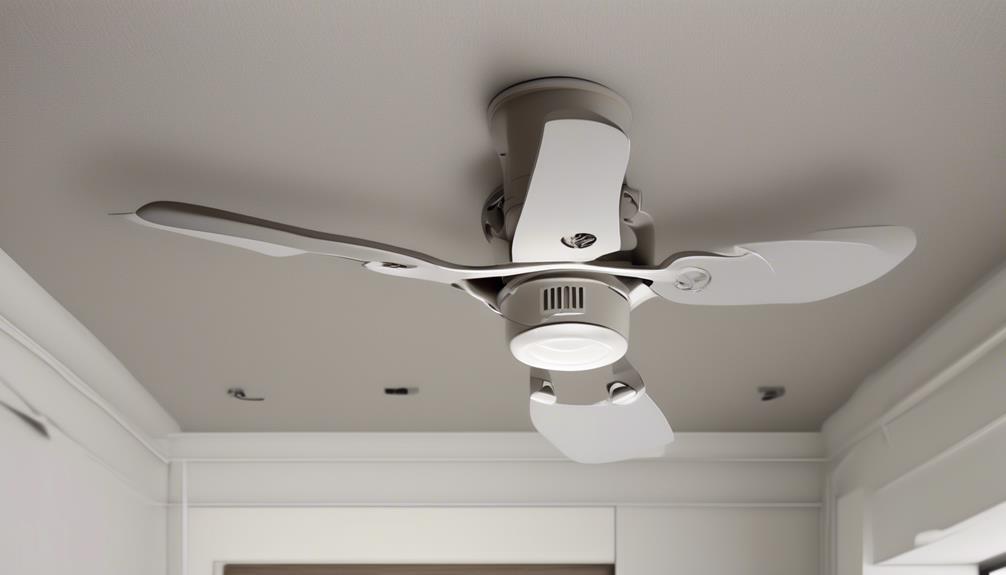
We need to address the issue of a loose motor housing in order to resolve the ceiling fan squeaking problem.
One possible cause could be that the motor screws are loose, causing the motor housing to vibrate and create the squeaking sound.
Another possibility is that the motor housing is misaligned, which can also lead to the same issue.
Motor Screws Are Loose
After conducting a thorough examination of the ceiling fan, it has been determined that the motor housing is experiencing a case of loose screws. This can cause the fan to emit a squeaking noise during operation.
To address this issue, there are several steps you can take:
- Tightening motor screws: Start by turning off the power to the fan and using a screwdriver to tighten any loose screws in the motor housing. Be careful not to overtighten, as this can cause damage.
- Replacing worn-out bearings: If tightening the screws doesn't resolve the squeaking, it's possible that the bearings in the motor are worn out. In this case, you'll need to replace them. Consult the fan's manual for instructions or consider seeking professional assistance.
- Regular maintenance: To prevent future issues, it's important to regularly inspect and maintain your ceiling fan. This includes checking for loose screws and lubricating the bearings as recommended by the manufacturer.
- Professional help: If you're unsure about performing these tasks yourself or if the problem persists, it's advisable to contact a professional electrician or a ceiling fan specialist for further assistance.
Motor Housing Is Misaligned
Having addressed the issue of loose screws in the motor housing, the next subtopic to explore is the possibility of a misaligned motor housing causing the ceiling fan to emit squeaking noises.
Motor housing maintenance plays a crucial role in ensuring the smooth operation of your ceiling fan. If the motor housing becomes misaligned, it can cause the fan to wobble and produce annoying squeaking sounds.
To troubleshoot motor alignment, start by turning off the fan and carefully inspecting the housing for any visible misalignment. If misalignment is detected, you can try realigning the motor housing by gently pushing or pulling it into the correct position. However, it's essential to exercise caution and avoid applying excessive force, as this may cause further damage.
If the misalignment persists, it's recommended to seek professional assistance to properly realign the motor housing and resolve the squeaking issue.
Loose Canopy
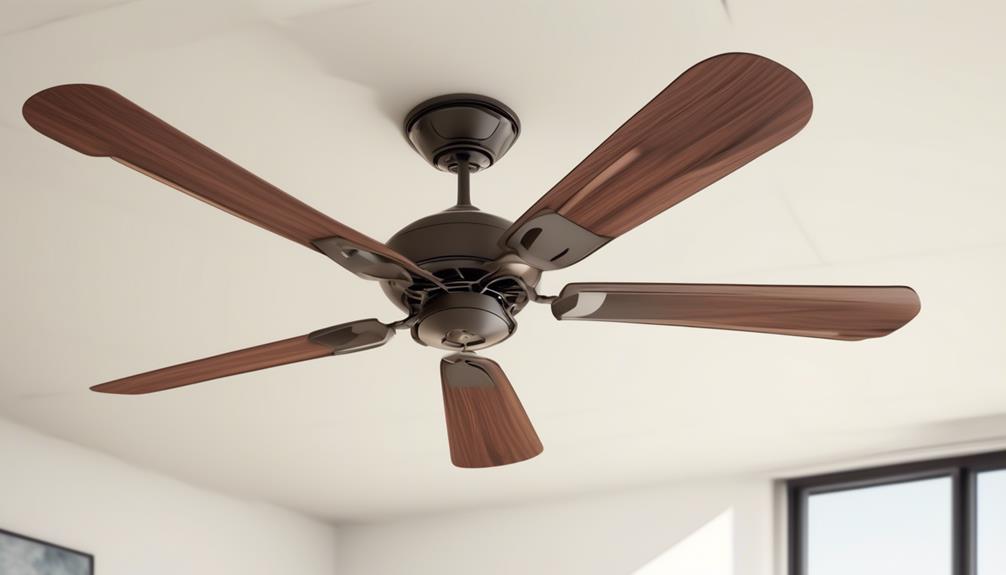
The loose canopy of a ceiling fan can often be the cause of annoying squeaking noises. When the canopy, which is the decorative cover that hides the electrical components of the fan, becomes loose, it can vibrate and rub against other parts of the fan, leading to squeaks and rattles. To address this issue, here are four steps you can take:
- Tighten the screws: Start by checking the screws that secure the canopy to the fan. If they're loose, use a screwdriver to tighten them. Be careful not to overtighten, as it can damage the canopy or the fan housing.
- Check the mounting bracket: Inspect the mounting bracket that holds the fan to the ceiling. Make sure it's securely attached and not causing any movement or wobbling. If necessary, tighten the screws or replace the bracket.
- Lubricate the canopy: Apply a small amount of lubricant to the areas where the canopy rubs against other parts of the fan. This can reduce friction and eliminate squeaking noises.
- Consider canopy replacement: If the canopy is damaged or worn out, it may need to be replaced. Consult the fan's manual or contact the manufacturer for guidance on canopy installation or finding a compatible replacement.
Improper Installation
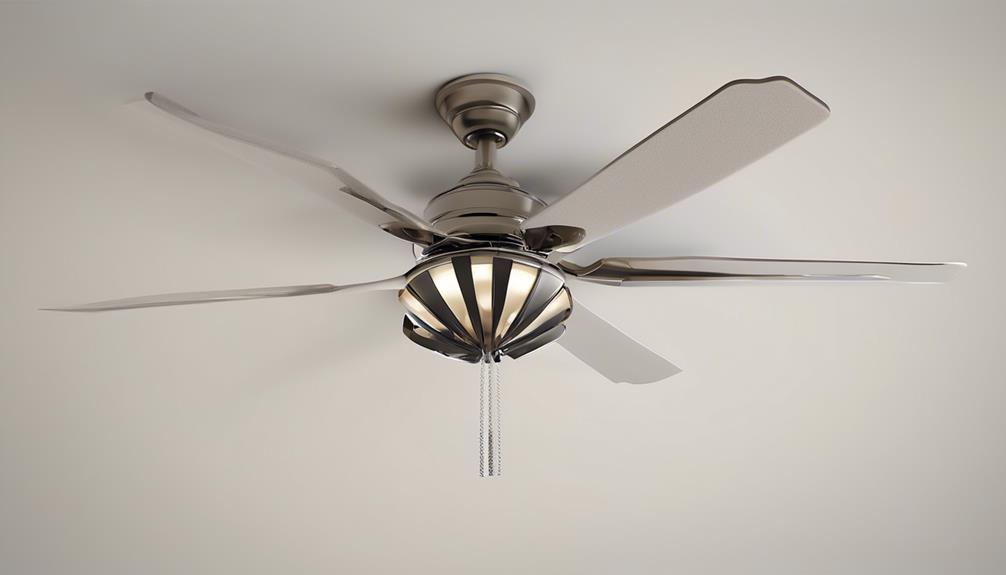
When addressing the issue of improper installation, it is crucial to ensure that all components of the ceiling fan are correctly assembled and secured to prevent any potential squeaking or other operational problems. Reliable installation techniques are essential to ensure the smooth and quiet operation of the ceiling fan. Here are some common installation issues that may cause squeaking and how to troubleshoot them:
| Installation Issue | Troubleshooting |
|---|---|
| Loose mounting bracket | Check if the mounting bracket is securely attached to the ceiling and tighten any loose screws or bolts. |
| Incorrect blade alignment | Make sure that each blade is properly aligned and balanced. Adjust the blades if necessary to eliminate any wobbling or rubbing against other components. |
| Improper wiring | Double-check the wiring connections to ensure they are correctly installed and securely connected. Refer to the manufacturer's instructions or consult a professional electrician if needed. |
| Loose fan motor housing | Inspect the motor housing and tighten any loose screws or bolts that secure it to the fan body. Ensure that the motor housing is properly aligned and centered. |
Lack of Lubrication
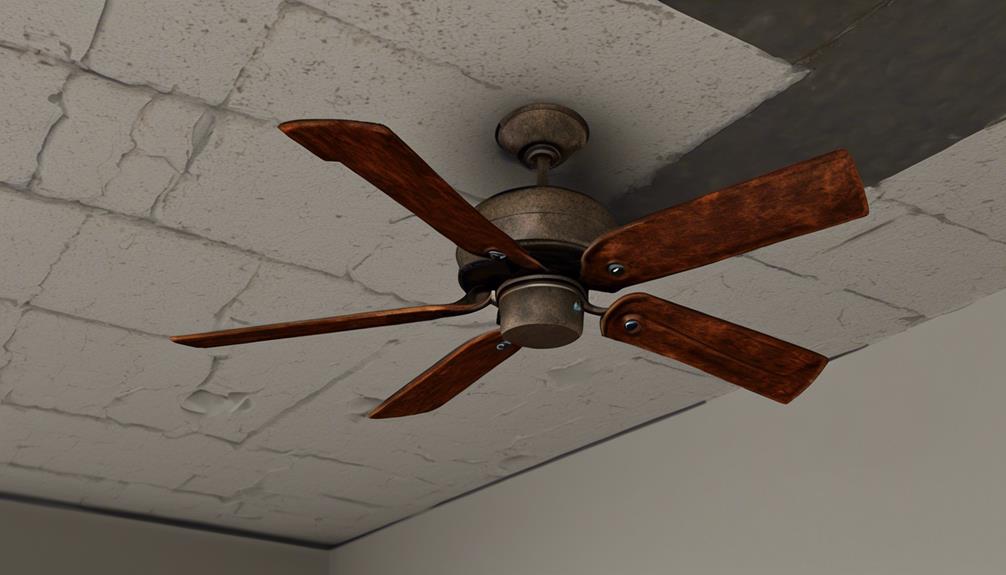
To ensure optimal performance and prevent squeaking, it's essential to address the issue of a lack of lubrication in the ceiling fan. Proper maintenance and reducing friction are key to resolving this problem. Here are four important steps to take:
- Identify the lubrication points: Locate the areas where lubrication is needed, such as the motor bearings, shaft, and any moving parts. Refer to the fan's manual for guidance, as different models may have varying lubrication requirements.
- Choose the right lubricant: Selecting the appropriate lubricant is crucial for effective lubrication. Use a high-quality, non-detergent oil or a silicone-based lubricant specifically designed for ceiling fans. Avoid using WD-40 or similar products, as they can attract dust and debris, causing further issues.
- Apply the lubricant: With a small dropper or brush, apply a few drops or a thin layer of lubricant to the designated lubrication points. Be careful not to over-lubricate, as excess oil can lead to dripping or accumulation of debris.
- Regular maintenance: Schedule periodic lubrication sessions as part of your ceiling fan's maintenance routine. This will help keep the fan running smoothly and minimize the chances of squeaking caused by insufficient lubrication.
Fan Blade Alignment Issues
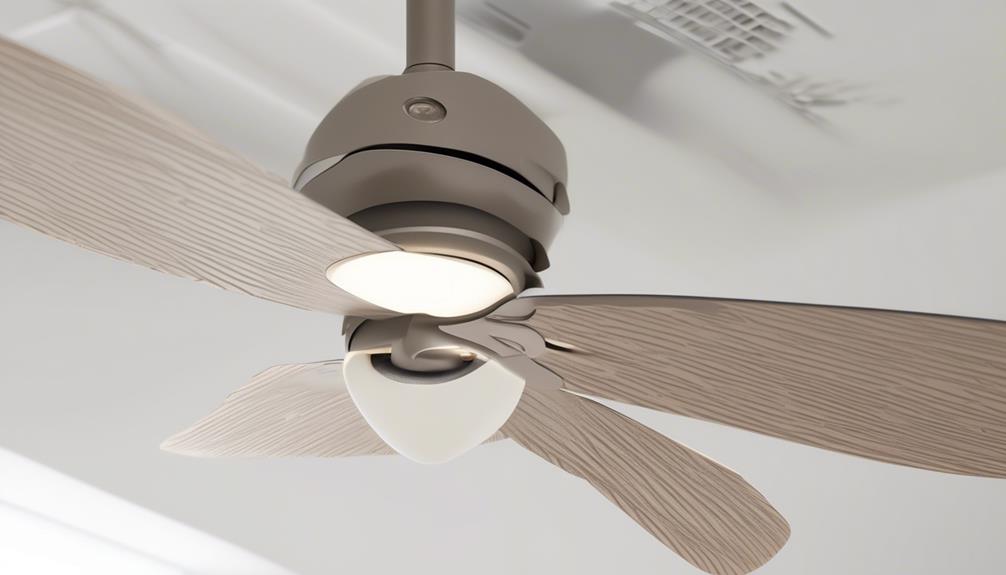
We can address the issue of fan blade alignment by following a few simple steps.
When a ceiling fan starts squeaking, it may be due to misaligned fan blades. To troubleshoot this problem, it's important to perform regular fan blade maintenance.
The first step is to turn off the fan and let it come to a complete stop.
Next, carefully inspect each fan blade for any visible signs of misalignment. Look for blades that are bent, warped, or not parallel to each other. If you notice any misalignment, use a wrench or screwdriver to loosen the screws holding the blades in place.
Gently adjust the blades until they're perfectly aligned. Once the blades are aligned, tighten the screws securely.
Finally, turn on the fan to test if the squeaking noise has been eliminated.
Can Squeaking in a Ceiling Fan Indicate a Larger Issue?
If your ceiling fan is making odd sounds like squeaking, it could be a sign of a larger issue. It may indicate problems with the motor, blades, or other internal components. To address this, consider implementing ceiling fan noise reduction techniques to minimize any potential issues.
Frequently Asked Questions
How Can I Prevent Dust and Dirt Buildup on My Ceiling Fan?
When it comes to ceiling fan maintenance, preventing dust and dirt buildup is crucial. Regularly cleaning your ceiling fan can help maintain its performance and prolong its lifespan.
To prevent dust and dirt buildup, use a soft cloth or a vacuum cleaner with a brush attachment to gently remove any accumulated debris. Pay attention to the blades, motor, and housing.
Additionally, consider using a ceiling fan duster or a microfiber duster with an extendable handle for hard-to-reach areas.
Can I Fix Loose Screws and Bolts on My Ceiling Fan by Myself?
We've all been there, dealing with the irritating sound of a squeaky ceiling fan. But fear not, because we can fix loose screws and bolts on our ceiling fan by ourselves!
Proper maintenance techniques, such as regular cleaning and lubrication, can prevent these issues from arising. However, if you do encounter loose screws and bolts, simply tighten them with a screwdriver or wrench.
It's a quick and easy fix to ensure your fan runs smoothly and quietly.
What Are the Signs of Worn-Out Bearings in a Ceiling Fan?
When it comes to troubleshooting ceiling fan noises, it's important to be aware of the signs of bearing damage. Worn-out bearings can cause your ceiling fan to squeak or make grinding noises. These noises may occur when you turn on the fan or when it's running at different speeds. If you notice these signs, it's likely that the bearings need to be replaced.
Regular maintenance and lubrication can help prevent bearing damage and keep your ceiling fan running smoothly.
Can Improper Installation Cause a Ceiling Fan to Squeak?
Improper installation can indeed cause a ceiling fan to squeak. When the fan isn't mounted correctly or the blades aren't balanced properly, it can create friction and vibration, resulting in annoying noises.
To troubleshoot the ceiling fan squeak, ensure that all the screws are tightened securely, the fan is level, and the blades are aligned correctly. Additionally, check for any loose or damaged parts that may need to be replaced.
How Often Should I Lubricate My Ceiling Fan to Prevent Squeaking?
When it comes to ceiling fan maintenance, one important aspect to consider is lubrication. Regularly lubricating your ceiling fan can help prevent squeaking. The frequency at which you should lubricate depends on several factors, such as the type of fan and its usage.
Generally, it's recommended to lubricate your fan every 6-12 months. However, if you notice any squeaking or unusual noise, it's advisable to lubricate it sooner.
Proper lubrication can eliminate common causes of fan squeaking and ensure smooth and quiet operation.
Conclusion
In conclusion, maintaining a perfectly functioning ceiling fan requires attention to detail and technical knowledge.
By addressing issues such as loose screws, imbalanced blades, worn-out bearings, dust buildup, loose motor housing, loose canopy, improper installation, lack of lubrication, and blade alignment problems, you can ensure a peaceful and efficient air circulation in your home.
So roll up your sleeves, embrace the problem-solving mindset, and enjoy the soothing breeze of a squeak-free ceiling fan.
- About the Author
- Latest Posts
Introducing Ron, the home decor aficionado at ByRetreat, whose passion for creating beautiful and inviting spaces is at the heart of his work. With his deep knowledge of home decor and his innate sense of style, Ron brings a wealth of expertise and a keen eye for detail to the ByRetreat team.
Ron’s love for home decor goes beyond aesthetics; he understands that our surroundings play a significant role in our overall well-being and productivity. With this in mind, Ron is dedicated to transforming remote workspaces into havens of comfort, functionality, and beauty.
Appliances
3 Essential Tips for RV-Friendly Portable Washers

- Pros and cons of using eco friendly laundry detergent in a portable washer.
- Tips for preventing detergent residue buildup in a portable washer
Are you exhausted from constantly looking for laundromats during your RV trips? We get it. That’s why we’re here to provide three key tips for RV-friendly portable washing machines.
While you might be thinking, ‘Do I really need a portable washer?’ trust us, having one on your RV can be a game-changer. In this guide, we’ll show you how to choose the right size washer that fits your RV’s limited space, understand the power and water requirements to ensure smooth operation, and provide you with maintenance and cleaning tips to keep your washer running efficiently.
So, let’s dive in and master the art of laundry on the road!
Key Takeaways
- Consider the laundry capacity needed for your RV.
- Look for compact and lightweight options with space-saving features.
- Choose a portable washer with high energy efficiency and water conservation features.
- Regularly maintain and clean your portable washer using recommended cleaning products.
Choosing the Right Size
One of the first considerations when selecting a portable washer for our RV is determining the appropriate size. Portable washer features and space-saving options play a crucial role in making this decision. When it comes to size, it’s important to find a washer that fits well within the limited space of an RV, while still providing enough capacity to meet our laundry needs.
To begin with, portable washers come in a range of sizes, typically measured in pounds of laundry capacity. It’s essential to consider the amount of laundry we anticipate doing on a regular basis. While a smaller capacity may be suitable for individuals or couples, larger families might require a washer with a higher capacity to accommodate their laundry demands.
Additionally, it’s important to consider the physical dimensions of the washer. RVs have limited space, so opting for a compact and lightweight washer can help maximize the available room. Some portable washers are designed with space-saving features such as folding handles, detachable components, or even stackable options that can fit neatly into tight spaces.
Understanding Power and Water Requirements
When considering the power and water requirements for our RV-friendly portable washer, we need to understand the necessary resources for optimal performance.
Energy efficiency is an important factor to consider when choosing a portable washer for your RV. Look for models that have a high Energy Star rating, as this indicates that they consume less energy and can help you save on your electricity bills.

Additionally, portable washer features such as load sensing technology and adjustable water levels can help you conserve water. These features ensure that the washer only uses the amount of water necessary to clean your laundry, which is particularly crucial when you have limited water supply in your RV.
It’s also important to check the power requirements of the portable washer. Make sure that the washer is compatible with the power source available in your RV, whether it’s a standard 120-volt outlet or a 12-volt DC power source.
Understanding the power and water requirements of your RV-friendly portable washer won’t only help you achieve optimal performance but also contribute to energy and water conservation.
Maintenance and Cleaning Tips
Let’s talk about how to properly maintain and clean your RV-friendly portable washer. Taking care of your portable washer is essential to ensure its longevity and optimal performance. Regular maintenance and cleaning will help prevent any potential issues and keep your machine running smoothly. Here are some common troubleshooting tips and recommended cleaning products to keep in mind:
| Common Troubleshooting | Recommended Cleaning Products |
|---|---|
| Leaking water | Vinegar and water mixture |
| Excessive noise | Mild detergent |
| Drum not spinning | Baking soda |
| Error codes | Citric acid |
If you encounter a problem such as leaking water, try using a mixture of vinegar and water to clean the machine’s seals and hoses. For excessive noise, use a mild detergent to clean the drum and remove any debris that may be causing the noise. If the drum is not spinning, try using baking soda to remove any buildup that may be hindering its movement. Lastly, if you receive error codes, using citric acid in the detergent compartment can help clean the sensors and resolve the issue.
Remember to always refer to your portable washer’s manual for specific maintenance instructions and troubleshooting tips. By following these guidelines and using the recommended cleaning products, you can keep your RV-friendly portable washer in great condition and enjoy clean laundry on your travels.
Frequently Asked Questions
How Long Does It Typically Take to Wash a Full Load of Laundry Using a Portable Washer?
Typically, it takes around 30 to 45 minutes to wash a full load of laundry using a portable washer.
However, it’s important to consider the capacity limitations of these machines. Most portable washers have a smaller capacity compared to traditional washers, so it may take longer if you have a larger load.
It’s always a good idea to follow the manufacturer’s instructions and not overload the machine to ensure efficient and effective washing.
Can I Use Regular Laundry Detergent in a Portable Washer, or Do I Need to Use a Specific Type?
Yes, you can use regular laundry detergent in a portable washer. However, there are some pros and cons to consider.
Using eco-friendly laundry detergent in a portable washer is a great option for those who want to reduce their environmental footprint. It can be gentler on your clothes and safer for the environment.
However, some eco-friendly detergents may not be as effective at removing tough stains. To prevent detergent residue buildup, make sure to use the recommended amount of detergent and run an extra rinse cycle if needed.
Is It Safe to Leave a Portable Washer Unattended While It’s Running?
Safety precautions should be taken when using a portable washer unattended. There are potential risks involved, such as water leakage or electrical malfunctions. It’s important to follow the manufacturer’s instructions and guidelines for safe operation.
Some tips to minimize risks include ensuring a stable surface, avoiding overloading the machine, and regularly checking for any signs of damage.
It’s always best to err on the side of caution when it comes to leaving a portable washer running without supervision.
Can I Wash Delicate Fabrics, Such as Silk or Lace, in a Portable Washer?
When it comes to washing delicate fabrics like silk or lace in a portable washer, there are a few things to keep in mind.
Firstly, check the manufacturer’s instructions to ensure that your specific model is suitable for these types of fabrics.
Secondly, use a gentle cycle and cold water to minimize any potential damage.
Lastly, consider placing delicate items in a mesh laundry bag for added protection.
With these precautions, you can safely wash your delicate fabrics in an RV-friendly portable washer.

How Noisy Are Portable Washers When in Operation?
When it comes to the noise level of portable washers, it’s important to consider their energy efficiency as well. These machines are designed to be compact and efficient, so they tend to operate quietly. While they do make some noise during operation, it’s typically minimal and shouldn’t disturb your RV neighbors or disrupt your peaceful campsite.
Plus, their energy efficiency means you can enjoy clean clothes without draining your RV’s power supply.
Conclusion
In conclusion, choosing the right size portable washer for your RV, understanding power and water requirements, and following maintenance and cleaning tips are essential for a smooth laundry experience on the road.
By coincidence, we stumbled upon a fellow traveler at a campsite who’d just purchased a portable washer based on our article. They were thrilled with the convenience and efficiency it provided.
So, take these tips into consideration and enjoy clean clothes wherever your adventures take you!
- About the Author
- Latest Posts
Introducing Charles, the Editor in Chief at ByRetreat, whose passion for interior design and editorial excellence elevates every remote workspace to new heights. With his keen eye for detail, impeccable taste, and expertise in design, Charles brings a wealth of knowledge and creativity to the ByRetreat team.
As the Editor in Chief of a renowned lifestyle blog, Charles has honed his skills in curating captivating content and staying up-to-date with the latest trends in interior design. His deep understanding of aesthetics and the power of storytelling through design enables him to create remote workspaces that are not only visually stunning but also rich in personality and meaning.
Appliances
4 Smart Tips for Extended Commercial Appliance Warranties

Did you realize that nearly 80% of commercial appliance malfunctions happen after the manufacturer’s warranty runs out? As business operators, we grasp the significance of safeguarding our assets and reducing unforeseen costs.
That’s why we have compiled four smart tips for extended commercial appliance warranties that will help you make informed decisions and ensure the longevity of your appliances.
In this guide, we will discuss choosing the right warranty provider, understanding coverage and exclusions, evaluating the cost and value, and maximizing the benefits of extended warranties.
By following these tips, you can have peace of mind knowing that your appliances are protected and your business operations can continue smoothly.
Let’s dive in and master the art of extended warranties!
Key Takeaways
- Choose a warranty provider with a good reputation and track record.
- Understand the coverage details and limitations of the warranty.
- Evaluate the cost and value of extended warranties.
- Maximize the benefits by understanding the claim process and maintaining your appliances.
Choosing the Right Warranty Provider
When selecting a warranty provider for extended commercial appliance warranties, we should consider their reputation and track record in the industry. Identifying reputable providers is crucial to ensure that we’re dealing with a company that has a history of delivering on their promises and providing excellent service to their customers. A reputable provider will have a strong presence in the market and positive reviews from satisfied clients. They’ll also have a proven track record of handling warranty claims efficiently and resolving issues promptly.
In addition to reputation, it’s important to compare warranty terms offered by different providers. We should carefully review the terms and conditions of each warranty to ensure that they meet our specific needs and requirements. This includes understanding the coverage provided, such as if it includes parts and labor costs, and the duration of the warranty. It’s also important to consider any limitations or exclusions that may apply.
Understanding Coverage and Exclusions
To fully understand the extent of coverage and any exclusions, we should carefully review the warranty terms and conditions for our extended commercial appliance warranties. Many people have common misconceptions about what’s covered under these warranties, which is why it’s so important to read the fine print. Here are some key points to consider:
- Scope of coverage: It’s crucial to understand what types of repairs or replacements are included in the warranty. This may vary depending on the provider and the specific appliance being covered. Some warranties may only cover certain parts or components, while others may offer more comprehensive coverage.
- Exclusions: Even though warranties provide coverage, there are often exclusions stated in the terms and conditions. These exclusions may include damage caused by misuse, neglect, or unauthorized repairs. It’s important to be aware of these exclusions to avoid any surprises when filing a claim.
- Duration of coverage: Extended commercial appliance warranties can vary in terms of their duration. Some warranties may provide coverage for a fixed period of time, while others may offer coverage until a certain number of repairs or replacements have been made. Understanding the duration of coverage can help us plan for future maintenance and repairs.
- Claim process: Familiarizing ourselves with the claim process is essential. This includes knowing who to contact, what documentation is required, and any specific procedures that need to be followed to ensure a smooth and efficient claim experience.
Evaluating the Cost and Value
To determine the cost-effectiveness of extended commercial appliance warranties, we need to assess their overall value. When weighing options and considering budget considerations, it is essential to evaluate the benefits and drawbacks of purchasing extended warranties for your appliances. To help you make an informed decision, we have created a table that outlines the key factors to consider:
| Factors to Consider | Benefits | Drawbacks |
|---|---|---|
| Coverage | Extended protection beyond the manufacturer’s warranty period | Additional cost |
| Repair Costs | Potential savings on repair expenses | Warranty cost may outweigh repair costs |
| Peace of Mind | Assurance that your appliances are protected | Limited likelihood of appliance failure |
By considering these factors, you can determine whether the cost of an extended warranty is justified by its value. It is important to note that budget considerations should not be the sole determining factor. While extended warranties may come at an additional cost, they can provide peace of mind and potential savings on repair expenses.
In the next section, we will explore strategies for maximizing the benefits of extended warranties, ensuring that you get the most value out of your investment.
Maximizing the Benefits of Extended Warranties
To maximize the benefits of extended warranties, we can employ strategies that optimize our investment. By understanding the claim process and exploring renewal options, we can ensure that our commercial appliance warranties provide us with the maximum value and protection.
Here are some smart tips for maximizing the benefits of extended warranties:
- Thoroughly understand the claim process: Familiarize yourself with the steps involved in filing a claim. Know the required documentation, such as proof of purchase and warranty information. By being prepared, you can expedite the claim process and minimize downtime.
- Regularly maintain your appliances: Proper maintenance is crucial for the longevity and performance of your commercial appliances. Follow the manufacturer’s guidelines for cleaning, servicing, and inspections. Regular maintenance not only extends the lifespan of your appliances but also helps prevent potential issues that may require warranty claims.
- Research renewal options: When your extended warranty is about to expire, explore renewal options offered by the warranty provider. Some providers offer extended renewal plans with additional coverage, giving you continued peace of mind and protection for your investment.
- Keep warranty documents organized: Maintain a dedicated folder or digital file for all your warranty documents. This ensures easy access to necessary information when filing a claim or renewing your warranty.
Frequently Asked Questions
How Can I Extend the Warranty on My Commercial Appliance if It’s Already Expired?
To extend the warranty on your commercial appliance after it has expired, there are several renewal options available.
You can contact the manufacturer or a third-party warranty provider to inquire about their extended warranty programs. They may offer coverage plans specifically designed for appliances with expired warranty coverage.
It’s important to carefully review the terms and conditions, as well as the cost, of these extended warranty options to ensure they meet your needs and budget.
Are There Any Specific Requirements or Limitations for Obtaining an Extended Warranty for Commercial Appliances?
When obtaining an extended warranty for commercial appliances, it’s important to be aware of the common exclusions in extended warranty coverage. These may include wear and tear, cosmetic damage, and misuse or negligence.
To choose the right extended warranty, consider factors such as the length of coverage, cost, and reputation of the provider.
It’s also crucial to thoroughly read and understand the terms and conditions of the warranty to avoid any surprises down the line.
Can I Transfer My Extended Warranty to a New Owner if I Sell My Commercial Appliance?
Yes, you can transfer your extended warranty to a new owner if you sell your commercial appliance. This ensures that the warranty coverage for used appliances continues with the new owner.
It’s important to check the specific requirements and limitations of your extended warranty to ensure a smooth transfer process. By transferring the warranty, you provide peace of mind to the new owner and protect them against any unexpected repair or replacement costs.
What Happens if My Commercial Appliance Breaks Down Multiple Times During the Extended Warranty Period?
If your commercial appliance breaks down multiple times during the extended warranty period, you may be eligible for claim reimbursement. The repair or replacement timeline will depend on the terms and conditions of your warranty.
It’s important to thoroughly review the warranty agreement to understand the process and any limitations. Our team is here to help ensure that your claims are handled efficiently and that you receive the necessary repairs or replacements in a timely manner.
Is There a Limit to the Number of Claims I Can Make Under an Extended Warranty for My Commercial Appliance?
There are limitations to the number of claims we can make under an extended warranty for our commercial appliance.
However, it’s important to note that extended warranties offer numerous benefits for commercial appliances. They provide peace of mind by covering repairs and replacements, reducing downtime and maintenance costs.
Conclusion
In conclusion, when it comes to extended commercial appliance warranties, there are several crucial considerations to keep in mind.
Firstly, choosing the right provider is essential. It’s important to research and compare different warranty providers to ensure they have a good reputation and offer comprehensive coverage.
Understanding coverage and exclusions is also crucial. Businesses should carefully review the terms and conditions of the warranty to know exactly what is covered and what is not. This will help avoid any surprises or disappointments down the line.

Evaluating cost and value is another important factor. Businesses should consider the cost of the warranty in relation to the potential repair or replacement costs of the appliances. They should also assess the value of the warranty by considering additional benefits such as extended service hours or priority service.
Lastly, maximizing benefits is key. Businesses should take advantage of all the benefits offered by the warranty, such as regular maintenance or discounted repairs. This will help ensure the appliances are well-maintained and any issues are addressed promptly.
By following these smart tips, businesses can make informed decisions that protect their investments. Just like a well-oiled machine, a well-chosen warranty can provide peace of mind and keep the business running smoothly. So don’t leave your appliances vulnerable, take action and secure their longevity today.
- About the Author
- Latest Posts
Introducing Charles, the Editor in Chief at ByRetreat, whose passion for interior design and editorial excellence elevates every remote workspace to new heights. With his keen eye for detail, impeccable taste, and expertise in design, Charles brings a wealth of knowledge and creativity to the ByRetreat team.
As the Editor in Chief of a renowned lifestyle blog, Charles has honed his skills in curating captivating content and staying up-to-date with the latest trends in interior design. His deep understanding of aesthetics and the power of storytelling through design enables him to create remote workspaces that are not only visually stunning but also rich in personality and meaning.
Appliances
3 Essential DIY HVAC Maintenance Tips Unveiled

Ah, the pleasures of tending to our HVAC systems! We understand the excitement of dedicating our valuable time to the upkeep and repair of these marvelous devices. But do not worry, dear reader, as we have revealed the tips to becoming skilled at DIY HVAC maintenance.
In this guide, we will unveil three essential tips that will ensure your HVAC system remains in perfect harmony. Get ready to dive into the world of air filters, thermostat settings, and outdoor condenser units. We will show you how to clean, check, and clear with ease, all while achieving that coveted mastery over your HVAC system.
So, let’s roll up our sleeves and get down to business, shall we?
Key Takeaways
- Regular maintenance, including cleaning air filters and checking thermostat settings, is essential for optimal HVAC system performance.
- Cleaning or replacing air filters prevents clogging and maintains a healthy indoor environment.
- Checking and maintaining thermostat settings ensures accurate temperature control and programming.
- Clearing debris from the outdoor condenser unit improves its performance and prevents airflow restriction.
Cleaning Air Filters Regularly
We recommend cleaning air filters regularly to ensure proper airflow and maintain optimal HVAC system performance. Replacing air filters is a crucial part of HVAC maintenance that often gets overlooked.
Air filters play a significant role in improving indoor air quality by capturing dust, pollen, and other airborne particles. Over time, these particles can accumulate on the filters, causing them to become clogged and obstructing the airflow. This can result in reduced efficiency and increased energy consumption.
By cleaning or replacing air filters on a regular basis, you can prevent these issues and maintain a healthy indoor environment.
Cleaning air filters is a relatively simple task that can be done by the homeowner. Start by turning off the HVAC system and locating the air filter. Remove the filter and inspect it for any visible dirt or debris. If the filter is washable, gently clean it with water and a mild detergent. Allow it to dry thoroughly before reinstalling. If the filter isn’t washable, it should be replaced with a new one. Remember to check the manufacturer’s recommendations for the appropriate filter type and replacement schedule.
Checking and Maintaining Thermostat Settings
To ensure optimal HVAC system performance, it’s important to regularly check and maintain the thermostat settings. The thermostat acts as the control center for your heating and cooling system, allowing you to adjust the temperature and program a schedule that suits your needs.
Start by adjusting the temperature settings to the desired level. This can be done manually or through programming. If you prefer a consistent temperature throughout the day, programming a schedule can help save energy and maintain comfort. Make sure to set different temperatures for when you’re away from home or asleep.
Regularly check the accuracy of your thermostat by comparing it to a separate thermometer. If there’s a discrepancy, recalibrate the thermostat to ensure accurate readings.
Keep the thermostat clean and free from dust and debris. Use a soft cloth to wipe away any buildup that may affect its functionality.
Lastly, check the batteries in your thermostat. Dead or low batteries can cause the thermostat to malfunction. Replace them as needed to ensure proper operation.
Clearing Debris From Outdoor Condenser Unit
Clearing debris from the outdoor condenser unit involves removing any dirt, leaves, and other obstructions that can hinder its performance. It’s important to regularly inspect and clean the condenser coil to ensure optimal functioning of the HVAC system.
To begin, it’s crucial to remove any vegetation that may have grown around the outdoor condenser unit. Plants, shrubs, or trees that are too close to the unit can restrict airflow and reduce its efficiency. Cut back any overhanging branches or foliage that may block the airflow and impede the unit’s ability to cool the air effectively.
Next, inspect the condenser coil for any debris buildup. Over time, dirt, leaves, and other particles can accumulate on the coil, obstructing the airflow and reducing its heat transfer capabilities. Gently brush away any debris using a soft-bristle brush or a vacuum cleaner with a brush attachment. Be careful not to damage the delicate fins of the coil during the cleaning process.
In addition to removing debris, it’s essential to inspect the coil for any signs of damage or corrosion. If any bent fins are detected, use a fin comb to straighten them out carefully. If there’s significant damage or corrosion, it’s recommended to contact a professional HVAC technician for further assessment and repair.
Regularly clearing debris and maintaining the condenser coil will help ensure that the outdoor unit operates efficiently and prolong its lifespan. By following these simple steps, you can optimize the performance of your HVAC system and maintain a comfortable indoor environment.
Frequently Asked Questions
How Often Should I Clean or Replace My Air Filters?
To improve the air quality in our homes, it’s essential to clean or replace air filters regularly. So, how often should we clean or replace them?
It’s recommended to clean or replace air filters every 1 to 3 months, depending on factors like the type of filter, the level of pollutants, and the frequency of HVAC system usage. Regular maintenance ensures that the air flowing through our HVAC system is clean and healthy, promoting a comfortable and safe living environment.
Can I Use Any Type of Air Filter for My HVAC System?
Can we use any type of air filter for our HVAC system?

It’s important to understand that not all air filters are created equal. There are different types of air filters available in the market, each with its own specifications and benefits.
Using the right filter for your HVAC system is crucial in ensuring optimal performance and indoor air quality. It’s recommended to consult with a professional to determine the best filter for your specific system and needs.
Are There Any Specific Thermostat Settings I Should Be Aware of During Different Seasons?
During different seasons, it’s important to adjust thermostat programming to maximize energy efficiency. By setting higher temperatures in the summer and lower temperatures in the winter, you can reduce the workload on your HVAC system and save on energy costs.
Additionally, utilizing programmable thermostats can help automate these adjustments, ensuring optimal comfort and efficiency.
How Can I Determine if the Outdoor Condenser Unit Is Blocked by Debris?
To determine if the outdoor condenser unit is blocked by debris, we can look for certain signs.
One key indicator is reduced airflow coming from the unit. If you notice that the air isn’t flowing as strongly as before, it could be a sign of blockage.
Another sign to watch out for is unusual noises coming from the condenser, which could indicate damage.
Regularly inspecting and cleaning the unit will help prevent any potential issues and ensure optimal performance.
What Are the Potential Consequences of Not Regularly Cleaning the Air Filters or Clearing Debris From the Outdoor Condenser Unit?
Neglecting HVAC maintenance can lead to serious consequences. Regularly cleaning air filters and clearing debris from the outdoor condenser unit is of utmost importance. Failure to do so can result in reduced airflow, decreased efficiency, and higher energy bills.
Additionally, dirty filters can lead to poor indoor air quality and potential health issues. By prioritizing regular HVAC maintenance, we ensure optimal performance, extend the lifespan of our system, and create a healthier and more comfortable living environment.
Conclusion
In conclusion, by regularly cleaning air filters, checking and maintaining thermostat settings, and clearing debris from the outdoor condenser unit, homeowners can ensure optimal performance and efficiency of their HVAC systems.
These essential DIY maintenance tips not only extend the lifespan of the system but also improve indoor air quality and reduce energy consumption.
By taking these simple steps, homeowners can enjoy a comfortable and healthy living environment while saving on utility bills.
- About the Author
- Latest Posts
Introducing Charles, the Editor in Chief at ByRetreat, whose passion for interior design and editorial excellence elevates every remote workspace to new heights. With his keen eye for detail, impeccable taste, and expertise in design, Charles brings a wealth of knowledge and creativity to the ByRetreat team.
As the Editor in Chief of a renowned lifestyle blog, Charles has honed his skills in curating captivating content and staying up-to-date with the latest trends in interior design. His deep understanding of aesthetics and the power of storytelling through design enables him to create remote workspaces that are not only visually stunning but also rich in personality and meaning.
-

 Vetted2 days ago
Vetted2 days ago15 Best Folding Beds for Small Spaces – Space-Saving Solutions for Comfort and Convenience
-

 Vetted20 hours ago
Vetted20 hours ago15 Best Waterproof Flooring Options for Your Bathroom – Ultimate Guide & Reviews
-

 Vetted6 days ago
Vetted6 days ago15 Best Grocery Carts to Make Shopping a Breeze
-

 Vetted2 weeks ago
Vetted2 weeks ago15 Best Gravel for Driveway: The Ultimate Guide for a Durable and Stunning Entrance
-

 Vetted4 days ago
Vetted4 days ago15 Best Steam Generators for Showering Bliss: Reviewed & Rated
-

 Beginners Guides3 weeks ago
Beginners Guides3 weeks agoI Inhaled Vinegar Fumes
-

 Vetted2 weeks ago
Vetted2 weeks ago15 Best Hot Tubs of 2024: Luxurious Relaxation at Your Fingertips
-

 Vetted4 weeks ago
Vetted4 weeks ago15 Best Blinds for Bathroom Windows to Enhance Privacy and Style


























